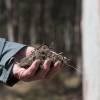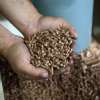
Red Hot Tips: Fire management for Tassie farmers
Posted 23 May 2024
Plantation Planning Species, sites and planting Managing trees Indigenous land management Tree Alliance
Fire is a land management tool that can protect trees, regenerate vegetation, reduce fuel load and manage weeds. It should be carried out with a fire management strategy, which includes getting the necessary permits and approvals.
We spoke to Andrew Cargill, Coordinator for the Red Hot Tips program, about the services available for Tasmanian farmers planning fire management on their property.
Red Hot Tips
Red Hot Tips is a free service for farmers and rural landholders. It is managed by the State Fire Management Council and supports people to actively manage bushfire risk on their land. The program encourages collaborative vegetation fire management and ecological sustainability across the landscape.
Andrew Cargill is the Coordinator for Red Hot Tips and works with farmers to plan and execute burns on their land, and to build knowledge across the Tasmanian community.
"We’re there to make things simpler for farmers and landowners to plan burns and manage their fire risk," says Andrew. "We have quite a vast network across Tassie. So we get out there and give landowners as much help as is needed.
"There’s two ways we work with people. One is we get farmers and other groups together for workshops. We show them our burn plan template, which can make it easier to get a permit.
"We teach people about basics of fire, things like fire conditions, how to light fire, temperatures and prescriptions around that. So people leave with a deeper understanding of the fundamentals.
"The other way we talk to people is farm visits with individuals. So we drive around for a site visit, kick the dirt, have a look and discuss a farmer’s priorities. That can take anywhere from an hour to all day. We don’t mind.
"We’ll work out a plan with the landowner. We look at their Forest Practices Plans and what they can do around fire. We give advice on legislative requirements, we provide assistance with permits and help to get everything approved.
"We also do burn plan training and on-ground mentoring. We’ll mentor people through the whole planning, operational execution and follow-up phases of a burn.
"When the day comes, we can also help them to execute the burn. We’re unique in that we actually provide the operational support. And do photo point monitoring for our post-burn follow-up, so we’ll come back every year and take the same photo to see how things have developed.
"Some people need help with all of it, some need help with the planning, some need help with execution. It’s about asking people what they need."

Fire for land management
Fire has been part of the Tasmanian landscape for thousands of years. Many species and types of vegetation need fire to survive long term. It can help to reduce fuel load, manage weeds and regenerate vegetation. This also reduces bushfire risk.
"Fire is a good tool for land management and it can be used in a variety of applications," says Andrew.
"It’s relatively inexpensive and can protect a landowner’s assets – whether it be their shed, their crops, the house, or their plantations. Because trees take a long time to grow and that’s an asset they need to maintain.
"Fire can also be used to regenerate pasture and crops and bush. So if an area hasn’t been burned for a while, it can be choked out by other plants. A burn tidies all that up so vegetation can continue to grow.
"Any vegetation types in Tassie need fire to regenerate. But it has to be at the right intensity at the right time of year.
"You’ve got general fuel reduction burns, which are usually hotter. And you’ve got your cool burning – which includes cultural burning in Indigenous land management. That’s more to maintain diversity of flora and fauna, and to open up areas to make it easier to walk through.
"Or in some cases, burning might not be the best outcome. You might have a damp forest or a rain forest that can’t burn. So we can also look at other treatments that are available like slashing or grazing."

Advice for farmers
Andrew recommends farmers to get in touch and discuss their needs. Fire management is a complex science, so seeking professional advice is recommended. Red Hot Tips can provide flexible support according to farmers’ needs.
"If you call or email us, we’ll help you," says Andrew. "We encourage people to get in touch and talk about what’s needed.
"The best thing people can do is contact us early. If you want to burn in autumn, don’t call us in autumn. Because we’ve already got a list of people that we’ll be working with.
"You want six months to get the burn plans organised, identify works and get the prep work done to have everything ready to go. Then when you get the weather window to burn, you don’t have to worry about all the background stuff. It’s already done.
"We’ve got some farmers in Tassie with quite a bit of land. And you can’t burn everything in a season, so scheduling is quite important.
"We’ve worked with farmers who identify say 10 blocks and we’ll do two in the first year, two the year after, and two the year after that, and so on. That way, there’s differing ages of fuel and not everything is due to be burned at the same time.
"The burn plans we develop with farmers are a great prompt. And farmers are often burning the same areas. So in years to come, they can pick up the same plan to build from.
"We want landowners to get to a point they don’t need us. We’re trying to help build that knowledge, that’s the end goal."
Find out more about managing trees, including with fire management, with the Tree Alliance knowledge hub at www.treealliance.com.au. You can learn more about Red Hot Tips at www.sfmc.tas.gov.au/RedHotTips





